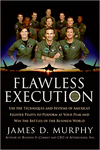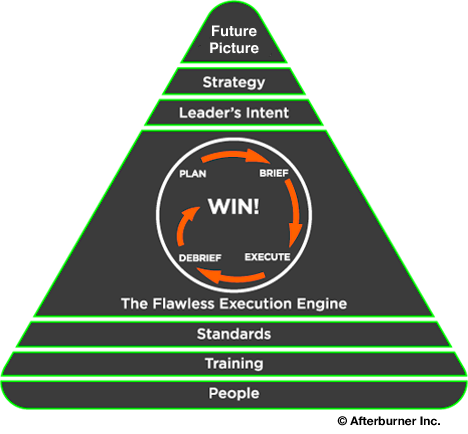Flawless Execution by James D. Murphy

James D. Murphy has taken the skills and knowledge he learned during his career as a US fighter pilot and applied these to the corporate world. If you are able to tune out the gung-ho enthusiasm and tales of US military successes and derring do, and can stick with the hammered-home fighter pilot analogy, this book is extremely easy to read with lots of anecdotes and examples to back up the author’s points.
As with many business books, this is divided up into a number of sections which start with you identifying your future vision/desired result, then breaking down the journey into manageable steps. The Flawless Execution model is based on a seven-step pyramid which sets out how a “mission” (there’s that analogy again – for mission read business plan), is executed, (this is essentially the big picture), and at the heart of this pyramid is the execution engine – a cycle called Plan-Brief-Execute-Debrief-Win. Each of the first four phases leads to “Win” at which point the process starts again (this bit is the fine detail planning section of how you run the mission).
This model has been used by the US military for nearly 50 years to reduce its mistake rate, and cut casualties and equipment losses. (See picture.)

James D. Murphy seeks to show you that Flawless Execution is a trainable, learnable, and most importantly, repeatable process.
Quote: “What is execution? Execution is nothing more than flying the brief. It is the unfolding of a scripted play.”
1. Future Picture: Individual execution is one thing…Organizational execution is everything!
At the top of the pyramid is the starting point: “Future Picture”. Put simply, this is your vision of the future as you want it to be; it needs to be detailed, and more importantly, it needs to be clearly communicated. Imagine briefing your team to plan a picnic. You assign one to arrange drinks, one for food, one for venue and so on. If your brief merely consists of, “plan a picnic”, and the assignation of tasks, would you be surprised if your team’s ideas of a perfect picnic don’t match your vision? Are you expecting tea and cake, or barbecue and beer? Did you want it in the garden or in a park? You need to be specific when sharing your Future Picture but you don’t need to micro manage either. What if you shared a picture of what you want your picnic to look like? It’s enough to show this to your team and ask them to make it happen. Empower them with a simple but clear image. A Future Picture should act as a beacon, giving all participants something to aim at.
There are 12 key descriptors that must be included in your Future Picture:
- What is your desired financial position?
- What is your current market position?
- What business areas do you intend to be in?
- Will you innovate or use off-the-shelf technology?
- What is the insider view of the company?
- What is the outside view of the company?
- What are the characteristics of your workforce?
- Brand? Yes or no?
- What is your corporate culture?
- What is your vision of corporate citizenship?
- Will your company be public or private?
- What is your incentive philosophy?
You must then attach a tangible, desired result to each descriptor: a Measure of Merit, for example:
9. Corporate Culture.
Key Descriptor: Entrepreneurial and autonomous with minimal management interference and a focus on productivity.
Measure of Merit: Everyone assessed for promotion. Productivity up from £x to £x.
Quote: “The Future Picture is the starting point for mission execution, and it is the end point.”
2. Strategy: You can have the best execution in the world…but if you execute against the wrong things you will lose.
Strategy is what connects the Future Picture with the individual plans your team will develop, and it is essentially the path to the end goal. Murphy defines strategy as asking four very simple questions:
- Where are we going to be in the future?
a. Map out all the elements of your business and include everything that touches or affects it, irrespective of how irrelevant it may seem. - What are we going to apply our resources to in order to get there?
a. Look at your map and identify the key places in your current business where you feel you can best focus your resources. - How are we going to do this?
a. How are you going to best apply your resources to achieve your Future Picture? - When or how are we going to exit, adapt or change course?
a. Decide ahead of time how and when you will finish.
Strategy shouldn’t be confused with tactics. Strategy is the plan; tactics are the methods. One example of this would be the decision to advertise on social media. The decision itself is strategy, but whether to choose Twitter, Facebook or Instagram is tactics.
Quote: “Good strategy will allow you to succeed even with inferior products or tactics.”
3. Leader’s Intent: It is not enough to just know the strategy…but the decisions behind the strategy.
Everyone involved in achieving the Future Picture must understand the vision, goal and strategy in order to best complete their role in making the mission a success. In order to give them this clarity, they must actively participate in open discussion. Open discussion, led from the top, ensures everyone can see the cause and effect of ideas in real time across all departments. It also ensures buy-in and positivity as everyone had a seat at the table when the decisions were made and are therefore apprised of the rationale behind them. This should be quick and dynamic as it’s the final step before execution. Every step thus far has built a package to deliver to the team – from here they’re fully briefed and will enter the Plan-Brief-Execute-Debrief-Win cycle.
Quote: “Plan in the open. And then watch the results.”
4. The Flawless Execution Engine: To win in a dynamic environment you must accelerate the experience of your team.
This is the longest chapter in the book, at nearly 100 pages. It is vital to understand that any planning you’ve done so far is big-picture stuff. To repeat the analogy, so far you’ve decided where the picnic will be, what type of catering you’d like, why you’re holding the picnic, how you’re going to use your resources to make it a success etc.
In this section, you’re nailing down the fine details – how many people, drinks selection, timings, roles on the day and so on. The key message here is autonomy; everyone on your team will have a measurable, quantifiable objective alongside the leader’s intent so they are able to adapt to changing conditions. This will depend on the person’s position so the CEO’s autonomy will be akin to a 10 lane motorway whilst the admin assistant’s might be closer to a narrow path.
This stage is broken down into five essential elements: Plan-Brief-Execute-Debrief-Win.
Plan
The planning stage takes place via a six-step process:
Step 1 – What’s the mission objective? This is different to the Future Picture as it’s something that can be achieved TODAY
Step 2 – What are the threats to our mission? Internal and external?
Step 3- What are our available resources?
Step 4 – What lessons have we learned from previous missions? And what can our collective experience bring to the table?
Step 5 – What is our course of action?
Step six – What are our contingency plans?
Brief
Once the plan is in place, it needs to be briefed to all participants. Briefs should be tight, and need to take into account the most up-to-date information as you have it. Give everyone the mission objective and relate it back to the Future Picture. Talk about external forces and possible threats which might impact the mission – are interest rates set to rise? Is there a change in stamp duty due imminently? Are you about to take on a new development? Is your location on the proposed route of a new railway line? State the admin standards – is this mission taking place per usual business practice or are you offering any points of difference i.e. a change in fee percentage or other incentive that everyone should be aware of? Finally, what’s the contingency? This is your ‘what if’ section: plans can be made now, in the briefing room, so that if issues should arise, everyone has planned a response ahead of time.
Execute
Once briefed, everyone involved can begin to execute the mission like an actor speaking lines in a play. Everyone knows where they are, where they’re going, and what’s happening next. The use of checklists and mutual support from the rest of the team goes a long way to achieving a successful mission, and helping to avoid the enemy of success which is task saturation.
Debrief
Murphy argues that this is the most important step in the entire process as it identifies ways in which performance can be improved by examining execution down to the finest detail. Essentially, it’s sharing best practice, and should be viewed as a positive experience. There are a number of things to remember when debriefing:
- It should take place immediately the mission is finished so that everything is fresh in people’s minds
- Only those who participated in the mission should be present
- The leader should start the process with a critical observation of their own performance
- It should be nameless and rankless so mistakes can be freely admitted and learned from, with feedback given from others where appropriate. Rather than saying, “Anna did this”, or “Tony didn’t do that”, the language should be anonymous i.e. “the Marketing Manager missed the deadline for X. Next time perhaps the Marketing Manager could ask for help at Y stage.”
- Only one person talks at a time and feedback should be sought
- There should be no fear of reprimand
- Debriefs are based on facts, not opinions.
Debriefs should follow the STEALTH model:
S: Set time/location/preparation
T: Tone (nameless, rankless, open communication, lead by example)
E: Execution versus objectives
A: Analyze execution
L: Lessons learned
T: Transfer lessons learned through your organisation
H: High note – positive summation
Win
Once the debrief on one mission is over, start another. Whether the mission went well or not, it’s time to get ready for the next one, so start planning – that’s the secret to Flawless Execution – you never leave the cycle. You simply move from one mission and its cycle, to the next one.
Quote: “It’s not who’s right, it’s what’s right.”
5. Standards: Standards bring you full circle – they are the ultimate contingency plan. Without them you come to a complete halt.
A strong set of standards are what you need as a back up should your plan for the Future Picture falter along the way, as these standards will keep people performing their mission. This chapter links into both the Training and People sections later in the book as the idea is that if you employ the right people to fit your culture, with the characteristics you’ve identified as key to your organisation, and train them to a high standard, you will be able to rely on minimum level of execution based on standards alone. Standards should be set out so firmly and so clearly, and the employees should be disciplined in adhering to them, that even the newest or most junior member of the team is executing their mission (even when you’re not looking!)
Quote: “We can’t be everywhere at once, and we sure can’t do it all ourselves. The answer is standards.”
6. Training: Training isn’t something that gets in the way. Training is the way that gets you there.
Murphy believes that training underpins everything and it is nothing less than the rock-hard foundation upon which Flawless Execution is built. Business changes daily so to get ahead you need to create the changes you want to happen, rather than reacting to changes created by external forces. If your basic skills are rusty, how can you stay ahead of the game? This is where training comes in. You practise, repeat and hone the essential skills you use in your work environment until they are second nature. The end goal is that your skills become so sharp they not only sustain but allow you to pull ahead of your competitors. There is a four-step process to successful training:
- DLO’s (Desired Learning Objectives) – What do we want to learn today?
- Demo/Do – I am going to show you how to do it, then I want you to do it. Over and over again until it’s as natural as breathing.
- Discipline – Having the discipline to use the training to execute within set standards.
- Continuation Training – Regularly allocating time to hone and fine-tune skills.
Quote: “To win, you must decide what you want your tomorrow to be, and then make it happen faster than the rate of change in your competitive environment.”*
7. People: Good companies make their people into exceptional workers.
The key point of this chapter is the importance of understanding your own corporate culture when hiring. Whilst experience and qualifications are important, it is vital to ensure a new hire will fit your culture. A US study of more than 50 corporations by Dr. Brad Smart found that hiring the wrong person in the $100,000 bracket ends up costing the company more than 14 times that in lost training costs, productivity, wasting other employees’ time and so on. Have you identified what you’re looking for when hiring? What characteristics are needed for people to excel in your environment? Do you want engaging, outgoing people on the frontline? Is it essential that your people like working together? It’s not always about the highest remuneration or benefits but rather giving people the pride and self-satisfaction they will get from being part of an exceptional team.
Quote: “…be forever mindful of that vague, nebulous thing called “fit”.”
The lessons in Flawless Execution are aimed at the individual: the point is that great companies are built around extraordinary individual execution; the better the individual executes, the better the company performs. Flawless Execution is never attainable but should always be attempted: at every step you must correct, adapt and solve, and be prepared for the unexpected. Pursuit is the way of life for fighter pilots and Murphy’s view is that the pursuit of Flawless Execution will get you where you want to be.
*Quote attributed to Colonel John Warden in “Winning in Fast Time”, Venturist Publishing, 2002
![]()
